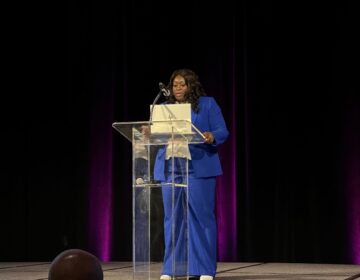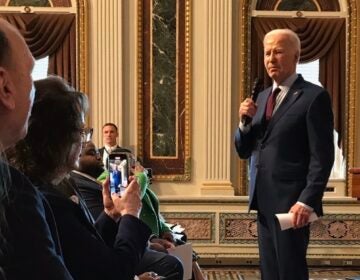Wilmington, the city with too many charter schools
Listen
Delaware shuttered the Maurice J. Moyer Academic Institute in June. (Avi Wolfman-Arent, NewsWorks)
Delaware’s largest city is “oversaturated” with charter schools. A new strategic plan could change that–and alter the school choice landscape.
Let’s start with a map.
Each red marker above represents one of Delaware’s 27 charter schools. Yellow indicates recently closed charters. And that lone purple dot buried in a cluster of red ones near Delaware’s northern border with Pennsylvania? That’s the H. Fletcher Brown Boys and Girls Club.
Brown services Wilmington’s East Side, a small, poor neighborhood wedged between the Brandywine River and I-495. Within one square mile of the club, there are ten charter schools. Within the city limits of Wilmington there are 12 charter schools.* Within the state of Delaware there are 27 charter schools. And within the United States, Delaware has the third-highest proportion of public school students attending charters.
Put another way, Brown serves the most charter-heavy neighborhood in the most charter-heavy city inside one of the nation’s most charter-heavy states.
“I mean there’s only so many kids,” says Rachel Kane, executive director of the club. “And at this point, a lot of choices.”
Charles Potter, a state representative from Wilmington, is more blunt.
“We are oversaturated with charter schools in the city of Wilmington,” he says.
Earlier this year, Potter authored a bill that prohibits the state from approving new charters in Wilmington. Upon its subsequent signing, Potter’s measure because the first law to limit or cap charter authorization in Delaware since the state passed its charter law in 1995.
The charter moratorium will last until the state develops a “strategic plan” for charter growth. That plan will govern what kind of new charters the state approves and, more crucially, where it approves them. It will mandate the state treat charters less as a independent enterprises and more as interdependent parts of the larger public school system. And for that reason, it could change the very nature of school choice in the First State.
A charter boom-and-bust
Wilmington has added eight charter schools since 2008.** Although that number may seem quaint, recall that Wilmington is roughly 1/10th the size of Baltimore and 1/20th the size of Philadelphia. Now imagine Philadelphia opening 160 new charter schools in the space of about 7 years, and you start to understand the changes happening in Wilmington.
What’s more, many of those newly-founded charters are still growing, adding a grade every year until they reach capacity. A recent report by the Wilmington Education Advisory Committee (WEAC) estimated that charter enrollment in the city will increase by 60 percent–from 3,868 to 6,167–over the next five years. There are a grand total of 11,595 Wilmington students in public schools.
In that same report, the WEAC–which was formed by Gov. Jack Markell late last year–recommended the state craft a strategic plan before opening any new charters in the city. Legislators quickly cemented the recommendation into law, in part because the circumstances demanded it.
Over the last two years, the state placed five charter schools on probation because of low projected enrollment. In 2015 alone, another four charters were within 10 students of missing their April enrollment targets, according to figures provided by the Delaware Department of Education. To be sure, there are a handful of in-demand charters with robust waiting lists, but the broader enrollment woes suggest a sector that has gotten crowded–perhaps unsustainably so.
“We’ve got such a concentration of charters in the city that in a sense they’re kind of feeding off one another and it’s not clear that they are all viable,” says Dan Rich, a professor of public policy at the University of Delaware and a counselor to the WEAC.
Taking a “snapshot”
Rich and the WEAC suggested a moratorium to prevent further saturation, and then a strategic plan to make sure a similar situation doesn’t arise in the future.
The plan contains two parts.
First, the Delaware Department of Education and the State Board of Education will recruit an outside group to perform a strategic needs assessment. The Statewide Review of Educational Opportunities (SREO) will examine demographic and enrollment trends across every type of public school to create what State Board executive director Donna Johnson calls a “snapshot” of all the educational programs available in the state. Some cities–including Denver, Camden, Baltimore–have done similar analyses, Johnson says, but Delaware will be the first to complete a statewide needs assessment.
The state hopes to complete the SREO by this November. Once done, it will inform the strategic plan–a sort of master document that will, among other things, determine where the state opens new charters. No longer will charters proliferate at their own pace and in whatever neighborhoods they prefer. Instead, the state government will cross-reference any new charter applications with the strategic plan, with the idea that it will try to open new ones in areas where it perceives a need. In that sense, charters will operate far more like traditional schools than private entities.
“We want the elements in public education to work in reinforcement to one another. We don’t want to unify them all, but we want them to connect with one another along the same path,” says Rich.
This would constitute a big change in Delaware’s charter sector, which has, to this point, operated as quasi-free-market with schools competing against each other for students. Locally, the strategic plan has near-unanimous support, but some national charter folks are more skeptical.
“I think this new policy is very problematic,” says Mike Petrilli, president of the Thomas B. Fordham Institute, a conservative-leaning education think tank out of Washington, D.C. and Ohio.
“Decisions like these become very political”
Petrilli’s objections are twofold.
First, he thinks any sort of government-managed strategic plan will be inherently corruptible. If a government body gets to determine where there’s need for a new school, Petrilli says, they’ll be subject to intense lobbying. Teacher’s unions, charter operators, and parent groups will all try to influence the strategic plan, turning into a vessel for special interests.
“Decisions like these these become very political,” Petrilli says. “Interest groups do all they can to keep new schools from opening up in neighborhoods where there are other schools existing–not because of what’s best for kids, but because of what they perceive is best for adults.”
Second, the plan inhibits competition.
Charters are private enterprises. Shouldn’t they be free to open where they choose and jockey with each other for students? And won’t that ultimately produce better schools than a government-engineered plan designed specifically to ensure that schools aren’t competing for students?
Petrilli compares it to a planning board saying a Target can’t move into the same neighborhood where there’s already a Walmart because it might harm the Walmart. Is that a role the government really wants to play? And might it also end up protecting mediocre businesses? A recent study by Petrilli’s organization found that closing bad schools may be unpopular, but it actually improves student achievement in the long term. By discouraging competition in the education marketplace might we actually be holding kids back?
Petrilli doesn’t believe the market for schools should be totally hands-off. He promotes rigorous accountability for charters and believes the government should play an active role in closing poor schools. It’s the idea of government gauging need and deciding where charters should open that bugs him.
“You do not want to create a situation where there is a political body that is under political control making decisions that may not be in the best interest of the consumers,” Petrilli says.
Dan Rich says charter schools aren’t Walmarts. They’re public schools financed largely with public money. It’s the government’s responsibility, therefore, to monitor them and determine where it wants to open them.
“This is is not the market model,” Rich says. “We’re making public investment in charters to strengthen the overall public education system.”
A big plan raises even bigger questions
Delaware’s strategic plan may have started as a response to charter overcrowding, but it also points to some pretty basic questions about charters.
How much competition is healthy when it comes to charters? Should charters exist within the larger school system, or outside it?
Twenty years after Delaware’s first charters opened, the state is still wrestling with their proper role within the larger public school system. The days of rapid charter expansion in Wilmington may be over, but the conversation over how to govern them is just beginning.
*There are 14 charter schools with Wilmington addresses, but only 12 in the actual city. There are two just outside the city proper, but both serve students from Wilmington.
**One of those eight charters is not within the city proper, but has a Wilmington address.
WHYY is your source for fact-based, in-depth journalism and information. As a nonprofit organization, we rely on financial support from readers like you. Please give today.





